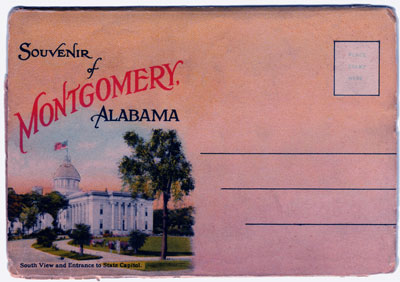Vintage travel card image of the State Capitol of Alabama in Montgomery, AL.
Montgomery Alabama became the state capitol on January 28, 1846, when it moved from Tuscaloosa, AL. The prosperity of the cotton industry in the area at that time influenced the state political power and the move to Montgomery.
The State of Alabama soon after played a part in national politics as representatives from six southern states met in Montgomery in 1861 to hold the Southern Convention resulting in the formation of the Confederate States of America. Montgomery became the first capitol of the Southern Nation with Jefferson Davis being inaugurated on the Montgomery state capitol steps. As a center of the Southern fight, Montgomery played a large role in the Civil War history of the United States. The new southern nation included South Carolina, Mississippi, Florida, Alabama, Georgia, Louisiana, and Texas with a constitution modeled after the northern U.S. Constitution.
In 1865, Montgomery fell to Union soldiers after a battle. It was not long after the Civil War ended with General Lee surrendering to General Grant on April 9, 1865 at Appomattox. Then Montgomery, like the other southern states, fell into rebuilding and healing from the effects of the war.
It prospered, partly due to the cotton industry, and in 1886 Montgomery became the first city in the United States to install city-wide electric street cars. The installation of the street car system helped Montgomery to grow into a modern city with suburban growth.
Montgomery is also famous for its role in the Civil Rights movement in the United States in the 1950’s and 60’s. It was in Montgomery, AL that Rosa Parks was arrested for refusing to give up her bus seat to a while man on December 1, 1955. This is often called the spark that flamed the Civil Rights movement and particularly the movement in Montgomery where there was bus boycott. Martin Luther King, Jr. was pastor of Dexter Avenue Baptist Church in Montgomery at the time. He helped found the Montgomery Improvement Association that organize the boycott.
This boycott and Parks’ arrest brought the issue to court, where it was ruled that the racial segregation was unconstitutional. The Supreme Court upheld this ruling in November, 1956, thus ending the boycott.
Non-enforcement of the Supreme Court ruling caused the creation of the Freedom Riders; people of mixed racial groups, who rode the buses into the deep south in protest against continued segregation on the U.S. interstate bus systems. The Freedom Ride of May 1961 in Montgomery sparked mob violence from opponents to desegregation. Once again, this caused another court ruling that desegregated all interstate public transportation permanently.
The Civil Rights battle continued with Montgomery being a central location due to Martin Luther King and his organization. Local civil rights leaders were protesting “Jim Crow” laws that kept blacks from registering to vote. They organized a march to Montgomery to petition Governor George Wallace for free voter registration. Violence erupted again in Montgomery contributing to Congress passing the Voting Rights Act of 1965 enforcing the rights of all minorities to vote.
Since the 1960’s Montgomery has grown and diversified into a major U.S. metropolis with many high-tech and other industries supporting a large racially mixed population. In 2007 it took on the task of restoring its historic downtown sections and riverfront, revitalizing the city.
